
Water stored in one of two reservoirs in the Bull Run Watershed, which has served the Portland metro area for more than a century.
Kaylee Domzalski / OPB
The lead levels in drinking water of some Portland-area homes have been found to have exceeded the federal action level for the first time since 2017.
The Portland Water Bureau announced Tuesday that its twice-annual testing revealed elevated lead levels in several metro area homes known to have lead solder in their plumbing systems.
Out of 104 homes tested, 14 had lead-in-water levels above 15 parts per billion. That’s the level at which the U.S. Environmental Protection Agency requires local utilities to notify the public and take corrective action. The EPA and U.S. Centers for Disease Control and Prevention say no level of lead consumption is safe for human health, especially in children.
“Our public’s health is our top concern, so we want to make sure the public is aware of these results,” said Scott Bradway, manager of the water bureau’s lead hazard reduction program.
Lead has been a pervasive problem in Portland’s drinking water system for years.
Water in the Bull Run Watershed, which serves Oregon’s largest metropolitan area, is naturally corrosive. When it comes in contact with lead solder in older plumbing systems, the water can develop concentrations of the toxic metal.
This is an issue primarily in the estimated 15,000 Portland homes constructed or plumbed between 1970 and 1985, which often used lead solder to join pipes. (Oregon mostly banned lead solder in 1985.)
Bradway said this is the ninth time test results have exceeded the federal action level since 1998.
“Our results are generally not too far below the federal action level, so it’s not incredibly shocking or alarming for us to exceed the action level,” he said.
Four years ago, lead levels of 17 parts per billion triggered the water bureau to gradually raise the pH level of treated drinking water to make it less corrosive. This latest round of test results showed lead levels at 21 parts per billion.
Bradway said that, so far, the bureau hasn’t found anything out of the ordinary that might have triggered the increase. The bureau relies on volunteers with known lead sources in their plumbing to submit samples.
“The homes that sample from round to round, they vary,” Bradway said. “So that variability of the pool of homes that sample, as well as variability in the chemistry on that day, in that time period, it all kind of causes the results to fluctuate some.”
The results come just a few months before construction is completed on new treatment facilities to control the corrosiveness of Bull Run water. The facilities are scheduled to be online by April 2022. The water bureau is also constructing a filtration plant to combat the microscopic parasite cryptosporidium.
The water bureau encourages Portlanders to have their water tested for lead by visiting leadline.org or calling 503-988-4000. Lead testing is free.
The bureau also suggests households with high lead-in-water levels should flush out lead by running their water for 30 seconds to 2 minutes. It also recommends using cold water for cooking and for making baby formula, because lead dissolves easier in hot water than cold. Boiling water will not get rid of lead.
Lead exposure can lead to brain and kidney damage, among other health issues. Infants, young children and pregnant people are most at risk.
